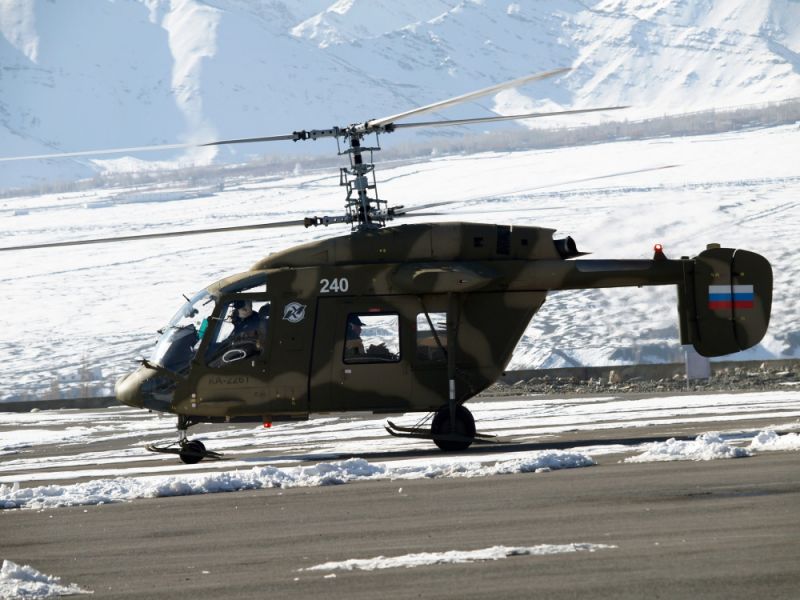Why delay Ka-226T?
By Rohit Srivastava

For the next two days, the Indo-Russian Inter-Governmental Commission is going to sit together to discuss various bilateral issues including strategic, military and payment related challenges. Post-CAATSA India is facing tremendous challenges in making payment to Russia for the import of weapon systems. To solve this problem, the two sides, reportedly, are exploring various options including Rupee-Ruble route.
One of the main agenda for the meeting is the delay in placing orders for the Russian Ka-226 light utility helicopter. India and Russia, in 2015, signed an agreement for co-production of 200 Ka-226T helicopters, to replace the four decades old and accident-prone Cheetah and Chetak helicopters, during the visit of Prime Minister Narendra Modi to Russia. Next year, the two sides signed the shareholders' agreement. As per the terms of the agreement, the two sides formed a joint venture (JV) company Indo-Russian Helicopters Pvt Ltd where the 50.5 per cent share is with Hindustan Aeronautics Ltd and rest with Russian Helicopters.
Out of 200, first 60 helicopters will come in flyaway condition from Russia, next batch of 40 helicopters will be assembled in India and rest will be manufactured in India. According to reports, the delivery timeline for 200 helicopters is around nine years.
A manufacturing plant is being established at Tumkaru, near Bengaluru. The foundation for which was laid by Prime Minister Narendra Modi in 2017. The JV received the request for proposal (RFP) in May this year.
Since then the one billion dollar deal is awaiting the order from the user.
In the last two months, India and Russia have signed agreements for import of five regiments of S-400 missiles and four advanced stealth frigates for over USD 7 billion. And the two sides are also expected to sign co-production agreement for over 7,00,000 AK-103 rifles soon. In comparison to these deals, the K-226 is a done deal and yet the Indian side has not been able to place the order.
India began its search for light utility helicopters in 2008 and multiple tenders later it dropped the idea and chose the Russian offer through the JV. The requirement is now a decade old but without any helicopter joining Indian fleet.
The delivery of the first helicopter should take a minimum of 12 months after signing of the contract. The local manufacturing will help strengthen the Indian light helicopter manufacturing capability. HAL, the Indian partner, is already manufacturing Advanced Light Helicopters and Light Combat Helicopter. It is also developing another light helicopter. The introduction of a much advanced co-axial rotor wing to the Indian industry is definitely going to strengthen the technical know-how of the Indian aerospace sector. In addition to this, the programme will also boost the local economy, including the creation of jobs for the local population. The spinoffs will be huge for the local economy.
In addition, the Ka-226T is also expected to participate in the Indian Navy’s 111 utility helicopters (NUH) programme. As reported earlier by IDI, “In April this year, an Indian team visited the Russian facility to witness the landing of the naval version of Ka-226 T on a ship deck and other demonstration of its capability. This was a kind of familiarisation of the Indian authorities with the capabilities of the platform which they are purchasing.”
The Russian chopper with its modular design which gives its user a lot of operational flexibility and the co-axial rotor which gives it stability in high crosswinds is its unique selling point. This also allows the helicopter to hover more precisely making it much more precise in rescue operations. Being a smaller utility helicopter, it can fit in smaller ships as well.
Another feature that makes Ka226T much-desired helicopter is its high rate of climb of around 12m/s and the lower rate of descent of around 8m/s, first makes it faster to climb to cruise height and the second makes it a safer to land on moving ship as it provides the pilot with more control. In rough sea condition, this can play a critical role in the success of the operations.
As the Ka-226T (naval) is a competitor in the NUH programme, it makes all the more reason for the Indian government to start the production as early as possible so that it is in a better position to assess the financial and technical viability of this chopper for the Navy.
The deal does not need much deliberation and this meeting should open the road to its execution. One can hope the momentum created by S-400 deal will get strengthened through the two-day meet and we may see the Ka-226 taking off.




